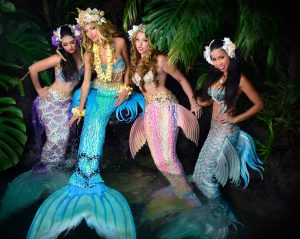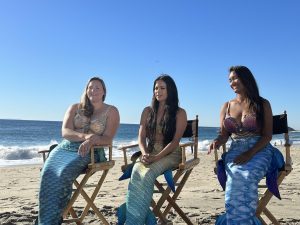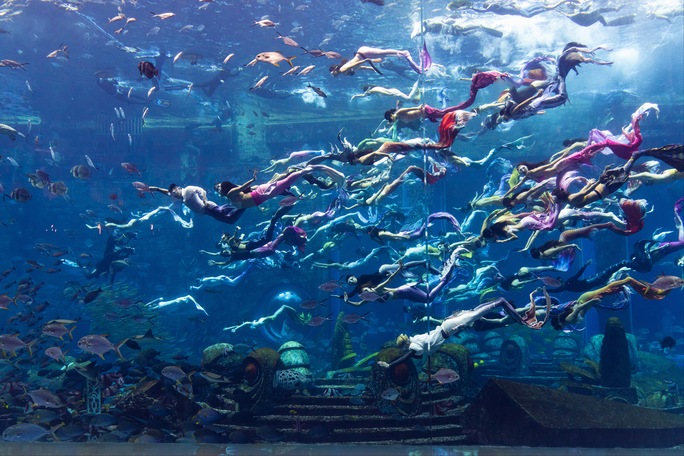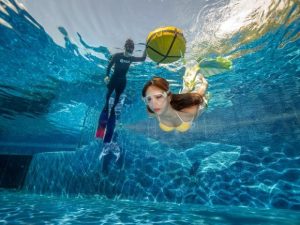Diving and movement of mermaids (Eng. Mermaiding) adds to the worldwide community of underwater explorers.
Diving begins with training children to dive
Human fascination with the underwater world, what lives there, and its exploration dates back to ancient history, as if encoded in our DNA code. Associated with this is a mythology that is common to virtually every culture that has sprung up spontaneously on every continent in one form or another: the mermaid. (Really merperson, but in English “mermaid” is a term we all know.)
Table of Contents
Mermaid movement in history
The earliest recorded references to fish-humans are more than 3,000 years old, but even the familiar "modern" concept popular in movies and television - top half human, bottom half fish - is hundreds of years old. What's new - and I bet you've noticed - is that the legend has become a modern reality these days.
The mermaid movement today
Starting as an underwater RPG by a small, passionate group of enthusiasts, scuba diving has become one of the fastest growing segments of diving. Borrowing from freediving, diving is its own form of breath-holding, emphasizing costume, underwater choreography and teamwork in elegant three-dimensional underwater "dances." This diving movement is a novelty, as such activity was not observed under the surface of the water in previous years.
The Mermaid Movement and Guinness World Records
If mermaid diving is in your area of interest, search YouTube for an amazing video of 100 mermaids diving at once to set the recent Guinness World Record in China, or learn more about PADI Mermaid, the new mermaid training course in this article.
Atlantis Sanya and PADI (Association of Professional Diving Instructors) launched a nationwide recruitment campaign for diving leaders, and eventually 110 divers were recruited, of which 90% reached instructor level.

As perhaps diving's most artistic and expressive form of underwater exploration, mermaiding is important because it attracts not only conventional freediving and scuba diving, but also a whole new one. The audience was interested in both its beauty and its ability to bring fantasy to life. As Gaia, the mermaid in Louise O'Neill's novel The Surface Breaks, says, “I was born in water and I am born of water.” Thanks to mermaid diving, a new generation of divers is similarly "born" among us, in search of adventure and saving the ocean.

The mermaid has arrived in the modern world
Mermaid diving is its own type of diving, and like scuba diving, scuba diving and freediving, it took time for the early pioneer enthusiasts to adopt, adapt and invent the gear and techniques that characterize it. Once they were introduced, official instructions and specially manufactured equipment appeared and were in demand, allowing the mermaid to become more popular. Now it's at a tipping point, and popularity breeds availability, which breeds popularity, and so on—just as it has with other types of diving.
Mermaid swimming is artistic
Diving or Mermaiding has been likened to underwater dancing because it is about grace, form, costume and team interaction. It can be watched even by the uninitiated, so it is also performance art. While other forms of diving have artistic aspects and uses, diving is really the only art form that is an art form in itself.
A mermaid only needs water
Most diving focuses on open water, but a mermaid only needs a pool or confined water, which is one of the reasons why mermaid diving has continued to grow during the pandemic. Travel restrictions didn't stop mermaids from local pools or even backyard pools during the total lockdown. This does not mean that mermaids cannot dive in open water (that is PADI Advanced Mermaid course focus) - you definitely can and many mermaids love it. But regardless, if you have an indoor heated swimming pool, even if you're on the coast in a howling midnight blizzard, you can enjoy mermaiding to your heart's content.
Mermaid swimming can help save the oceans
Diving is perhaps the most all-encompassing activity, and mermaiding can be the most eye-opening of all. While many freedivers and divers are attracted to mermaids, mermaids attract non-divers who are interested in artistic expression, culture, mythology, or fantasy/cosplay—people who might not have otherwise considered scuba diving. But like you and me, when they discover the underwater world, they learn to care for it. Many join us as ocean advocates and to expand their diving experience PADI Freediver and PADI Open Water Diver in courses. So when they become PADI Mermaids, they become part of our mutual movement to restore balance between humanity and the oceans.
How to apply for the mermaid movement?
And by the way, if mermaids always inevitably seem like photogenic youngsters, in reality, mermaid divers are all genders and all kinds of people. Mermaid diving is inclusive of different cultures, body types and ages, just like the legends it sprang from, with many people taking it up. Interested? Then do it - a PADI Mermaid and Freediving instructor will welcome you with open arms PADI Freediver Freediving course!

WHAT IS TEACHED IN A FREIDIVING COURSE?
The PADI Freediver training course consists of three stages - knowledge development, closed water sessions (when possible) and open water sessions. As you progress, you'll learn how your body reacts to holding your breath and how water pressure affects you as you descend. You will also learn about diving equipment, important safety rules and safety procedures.
In a confined water, such as a swimming pool, you learn how to breathe, then train your breathing forces by holding your breath (static apnea) and swimming (dynamic apnea). You will also practice basic rescue techniques and learn safety procedures.
During at least two open water sessions, you engage in scuba diving, breathing, either by pulling yourself along the line first (free immersion) or by following a line (constant weight). You learn to gradually increase your depth by relaxing and enjoying each dive. Rescue practices are another key component of open water sessions.
Where to apply for diving training in Latvia?
🤿😀 If you are looking for advice or help on the theory of cold, the sport of diving with or without balloons, call a PADI diving instructor t. 220-77-202 (Whatsapp 220-77-202) to find advice on proper human survival in water and freediving related training.


